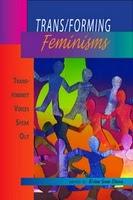Trans/forming Feminisms: Trans-Feminist Voices Speak Out

Krista Scott-Dixon’s collection, Trans/forming Feminisms: Transfeminist Voices Speak Out blending gender theory and a remarkable range of personal narratives, provides a powerful, complex and deeply moving introduction to a relatively neglected and misunderstood area of feminist study: the experiences, gendered multiplicity, personal and social struggles, and the touching humanity of people identified—for lack of a better term—as trans.
The book thoroughly explodes the dualistic conception of gender, reviews research into the “constructedness” of our gendered identities and demonstrates dramatically some of the diverse ways in which gender is made manifest. Carefully produced and edited, Trans/forming Feminisms ought to be snatched up by women’s and gender studies instructors—it will be a terrific addition to introductory classes, but it should also resonate with all of those who are willing to entertain the idea that the human world is not divided tidily into female and male.
Like many scholars who see critical theory as a central part of their professional mission, the editor invokes bell hooks’ understanding of theory as a “location for healing.” To theorize trans identity and experience is to take steps towards challenging oppression, towards understanding and complicating a central part of our identities. She rejects a facile embrace of trans identity among non-trans sympathizers (“it’s hip to be trans; maybe I’m trans, too”), and the narratives are as painful as they are celebratory.
The legal and ethical issues the book raises such as events and organizations with “womyn-born womyn only” policies or “no penis” policies similarly resist easy answers or sloganeering, but reveal the complex and uncertain alliance between self-described feminists and trans people. Just how inclusive have feminist organizations been? Can exclusivity be a legitimate strategy?
The terms used to categorize different identities, different understandings of sexual selves, are messy, overlapping, ambiguous—an indication that the theory is new, and that exploration of trans experience is still in its formative stages. While metaphors such as gender-bending or a gendered continuum have been useful constructs, names for the wide variety of gendered expression can be baffling: genderqueers, birls, FTMs and MTFs—the categorical language seems inadequate. And yet labels, however damaging they can be in one sense, afford a kind of group identity and can have explanatory and healing power. Dixon’s book might be the most accessible and potentially influential treatment this subject has yet received.